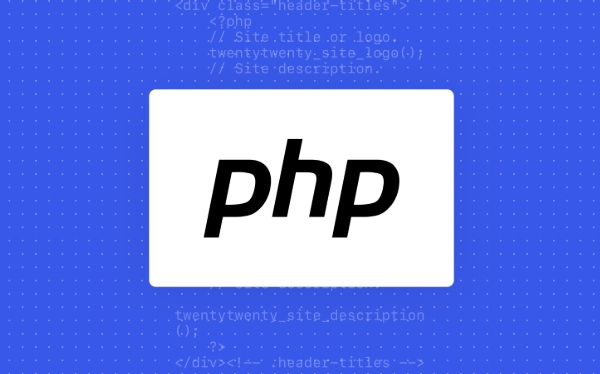How to create a custom session handler in PHP?
Jul 14, 2025 am 12:58 AMTo customize the session processing mechanism in PHP, you need to implement the SessionHandlerInterface interface and register the handler. 1. Implement six core methods: open(), close(), read(), write(), destroy() and gc() to complete the session storage logic; 2. Create a custom handler class instance and register it through session_set_save_handler(); 3. Call session_start() before use to start the session. Suitable for improving performance, centralized management and extension functions, it is recommended to pay attention to permission control, concurrency issues and security protection to ensure the correct operation of GC and ensure the security of session ID.

In PHP, the default session processing mechanism can already meet most scenarios, but sometimes we need to customize the session storage method, such as storing session data into a database, Redis or other storage system. At this time, you need to create a custom session handler . It is not complicated to implement, the key is to understand the process and interface.

Implement the SessionHandlerInterface interface
PHP provides a built-in interface SessionHandlerInterface that defines several core methods in the session lifecycle. You need to implement these methods yourself:
-
open($savePath, $sessionName): Called when opening the session -
close(): Close the session -
read($id): read data according to session ID -
write($id, $data): write session data -
destroy($id): destroy the specified session -
gc($maxLifetime): garbage collection mechanism
You can regard these methods as logical encapsulations of "addition, deletion, modification and search". For example, if you plan to save session to MySQL, then read() method is responsible for finding records of the corresponding session ID from the database.

Register a custom handler
After writing the class, you need to tell PHP to use your own handler. This step is done through session_set_save_handler() function. Note that in PHP 7.0 and above, this function can accept an object that implements SessionHandlerInterface .
Remember to start the session ( session_start() ) before use, otherwise it will not take effect. The sample code is as follows:

$handler = new MyCustomSessionHandler(); session_set_save_handler($handler); session_start();
Pay attention to permission issues here, especially if the session directory originally had permission restrictions, you should also ensure that your storage method is safe and reliable after changing to a custom handler.
Common application scenarios and suggestions
Why do custom session storage?
- Improve performance : For example, using Redis instead of file storage can improve concurrent access speed.
- Centralized management : In a multi-server environment, unified session storage is convenient for sharing.
- Easy to expand : You can do more with logging, monitoring and other tools.
Things to note
- Don't forget to set
session.save_handlertouser, otherwise the custom handler will not be called. - If you are using PHP-FPM, pay attention to the possible competition problems under concurrent requests.
- In the
write()method, do not miss the last modification time of the update session, otherwise GC may delete the active session by mistake. - To consider whether the generation of session ID is safe, you can use
session_regenerate_id()to prevent session fixation attacks if necessary.
Basically that's it
There are actually not many core steps to create a custom session handler, but the details are easily overlooked, especially in production environments where concurrency, performance and security should be considered. As long as you clarify the role of each method and implement it in combination with actual needs, you can successfully complete the custom session processing.
The above is the detailed content of How to create a custom session handler in PHP?. For more information, please follow other related articles on the PHP Chinese website!

Hot AI Tools

Undress AI Tool
Undress images for free

Undresser.AI Undress
AI-powered app for creating realistic nude photos

AI Clothes Remover
Online AI tool for removing clothes from photos.

Clothoff.io
AI clothes remover

Video Face Swap
Swap faces in any video effortlessly with our completely free AI face swap tool!

Hot Article

Hot Tools

Notepad++7.3.1
Easy-to-use and free code editor

SublimeText3 Chinese version
Chinese version, very easy to use

Zend Studio 13.0.1
Powerful PHP integrated development environment

Dreamweaver CS6
Visual web development tools

SublimeText3 Mac version
God-level code editing software (SublimeText3)

Hot Topics
 How to get the current session ID in PHP?
Jul 13, 2025 am 03:02 AM
How to get the current session ID in PHP?
Jul 13, 2025 am 03:02 AM
The method to get the current session ID in PHP is to use the session_id() function, but you must call session_start() to successfully obtain it. 1. Call session_start() to start the session; 2. Use session_id() to read the session ID and output a string similar to abc123def456ghi789; 3. If the return is empty, check whether session_start() is missing, whether the user accesses for the first time, or whether the session is destroyed; 4. The session ID can be used for logging, security verification and cross-request communication, but security needs to be paid attention to. Make sure that the session is correctly enabled and the ID can be obtained successfully.
 PHP get substring from a string
Jul 13, 2025 am 02:59 AM
PHP get substring from a string
Jul 13, 2025 am 02:59 AM
To extract substrings from PHP strings, you can use the substr() function, which is syntax substr(string$string,int$start,?int$length=null), and if the length is not specified, it will be intercepted to the end; when processing multi-byte characters such as Chinese, you should use the mb_substr() function to avoid garbled code; if you need to intercept the string according to a specific separator, you can use exploit() or combine strpos() and substr() to implement it, such as extracting file name extensions or domain names.
 How do you perform unit testing for php code?
Jul 13, 2025 am 02:54 AM
How do you perform unit testing for php code?
Jul 13, 2025 am 02:54 AM
UnittestinginPHPinvolvesverifyingindividualcodeunitslikefunctionsormethodstocatchbugsearlyandensurereliablerefactoring.1)SetupPHPUnitviaComposer,createatestdirectory,andconfigureautoloadandphpunit.xml.2)Writetestcasesfollowingthearrange-act-assertpat
 How to split a string into an array in PHP
Jul 13, 2025 am 02:59 AM
How to split a string into an array in PHP
Jul 13, 2025 am 02:59 AM
In PHP, the most common method is to split the string into an array using the exploit() function. This function divides the string into multiple parts through the specified delimiter and returns an array. The syntax is exploit(separator, string, limit), where separator is the separator, string is the original string, and limit is an optional parameter to control the maximum number of segments. For example $str="apple,banana,orange";$arr=explode(",",$str); The result is ["apple","bana
 JavaScript Data Types: Primitive vs Reference
Jul 13, 2025 am 02:43 AM
JavaScript Data Types: Primitive vs Reference
Jul 13, 2025 am 02:43 AM
JavaScript data types are divided into primitive types and reference types. Primitive types include string, number, boolean, null, undefined, and symbol. The values are immutable and copies are copied when assigning values, so they do not affect each other; reference types such as objects, arrays and functions store memory addresses, and variables pointing to the same object will affect each other. Typeof and instanceof can be used to determine types, but pay attention to the historical issues of typeofnull. Understanding these two types of differences can help write more stable and reliable code.
 Using std::chrono in C
Jul 15, 2025 am 01:30 AM
Using std::chrono in C
Jul 15, 2025 am 01:30 AM
std::chrono is used in C to process time, including obtaining the current time, measuring execution time, operation time point and duration, and formatting analysis time. 1. Use std::chrono::system_clock::now() to obtain the current time, which can be converted into a readable string, but the system clock may not be monotonous; 2. Use std::chrono::steady_clock to measure the execution time to ensure monotony, and convert it into milliseconds, seconds and other units through duration_cast; 3. Time point (time_point) and duration (duration) can be interoperable, but attention should be paid to unit compatibility and clock epoch (epoch)
 How to pass a session variable to another page in PHP?
Jul 13, 2025 am 02:39 AM
How to pass a session variable to another page in PHP?
Jul 13, 2025 am 02:39 AM
In PHP, to pass a session variable to another page, the key is to start the session correctly and use the same $_SESSION key name. 1. Before using session variables for each page, it must be called session_start() and placed in the front of the script; 2. Set session variables such as $_SESSION['username']='JohnDoe' on the first page; 3. After calling session_start() on another page, access the variables through the same key name; 4. Make sure that session_start() is called on each page, avoid outputting content in advance, and check that the session storage path on the server is writable; 5. Use ses
 How does PHP handle Environment Variables?
Jul 14, 2025 am 03:01 AM
How does PHP handle Environment Variables?
Jul 14, 2025 am 03:01 AM
ToaccessenvironmentvariablesinPHP,usegetenv()orthe$_ENVsuperglobal.1.getenv('VAR_NAME')retrievesaspecificvariable.2.$_ENV['VAR_NAME']accessesvariablesifvariables_orderinphp.iniincludes"E".SetvariablesviaCLIwithVAR=valuephpscript.php,inApach






